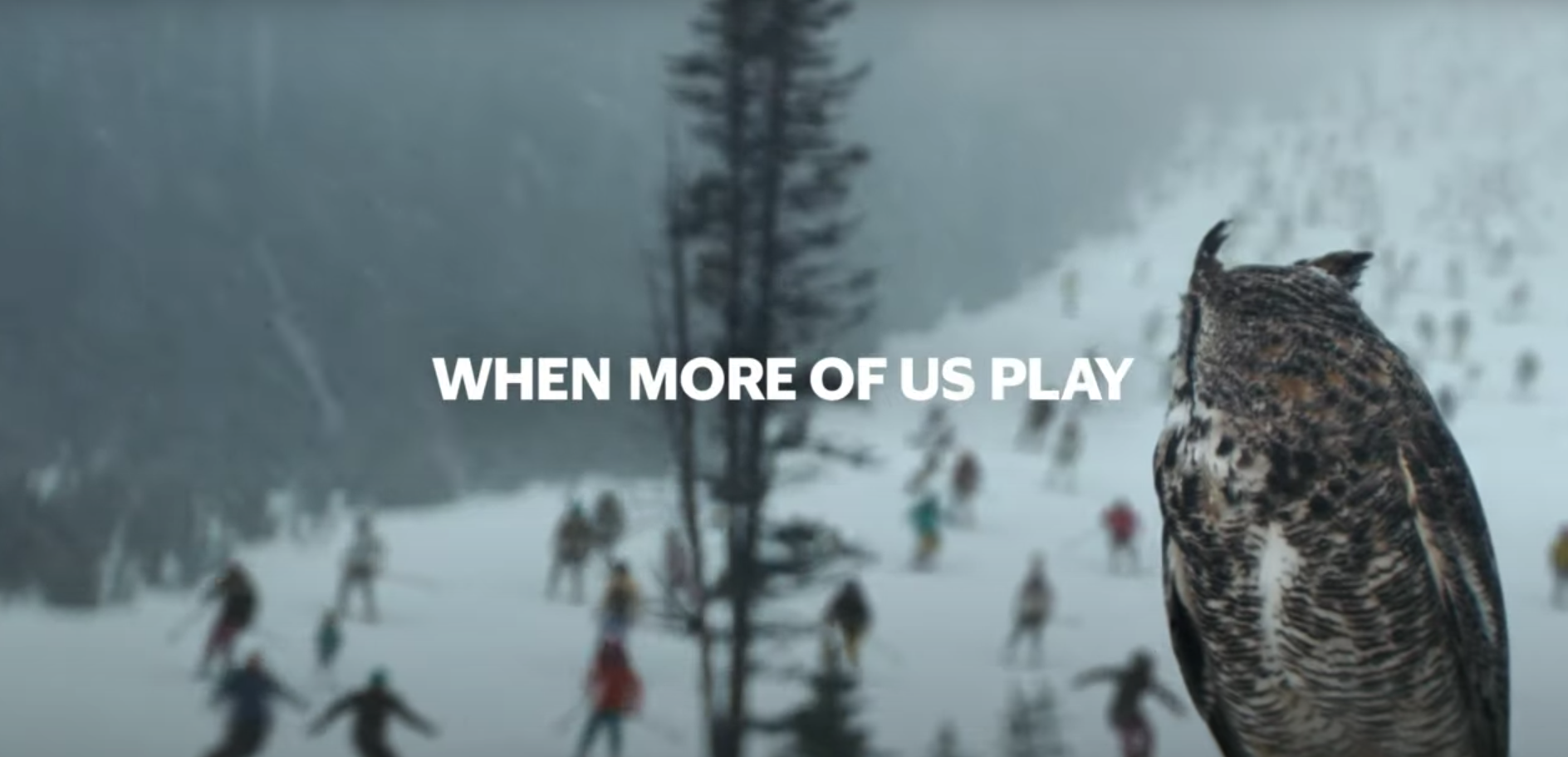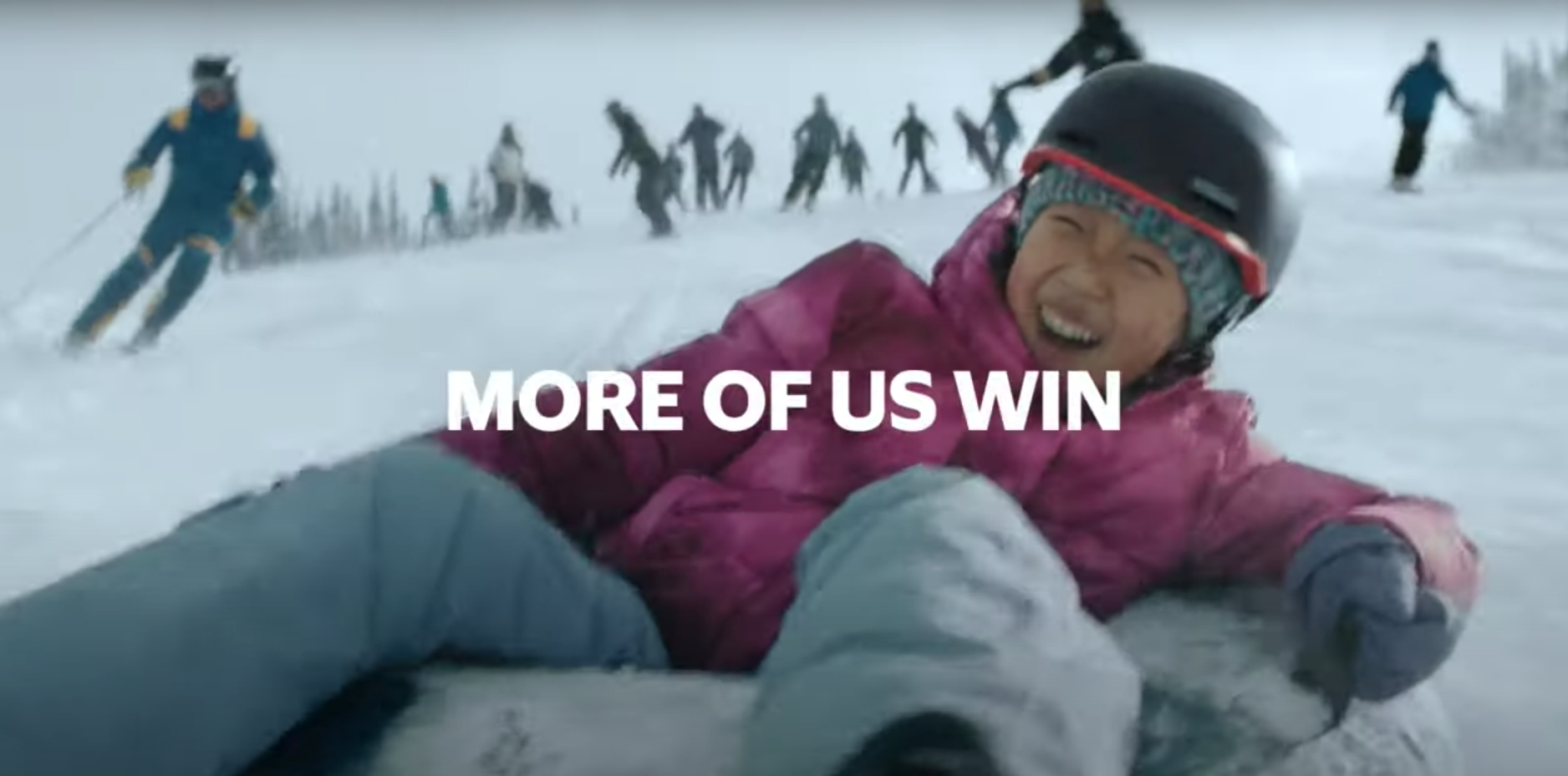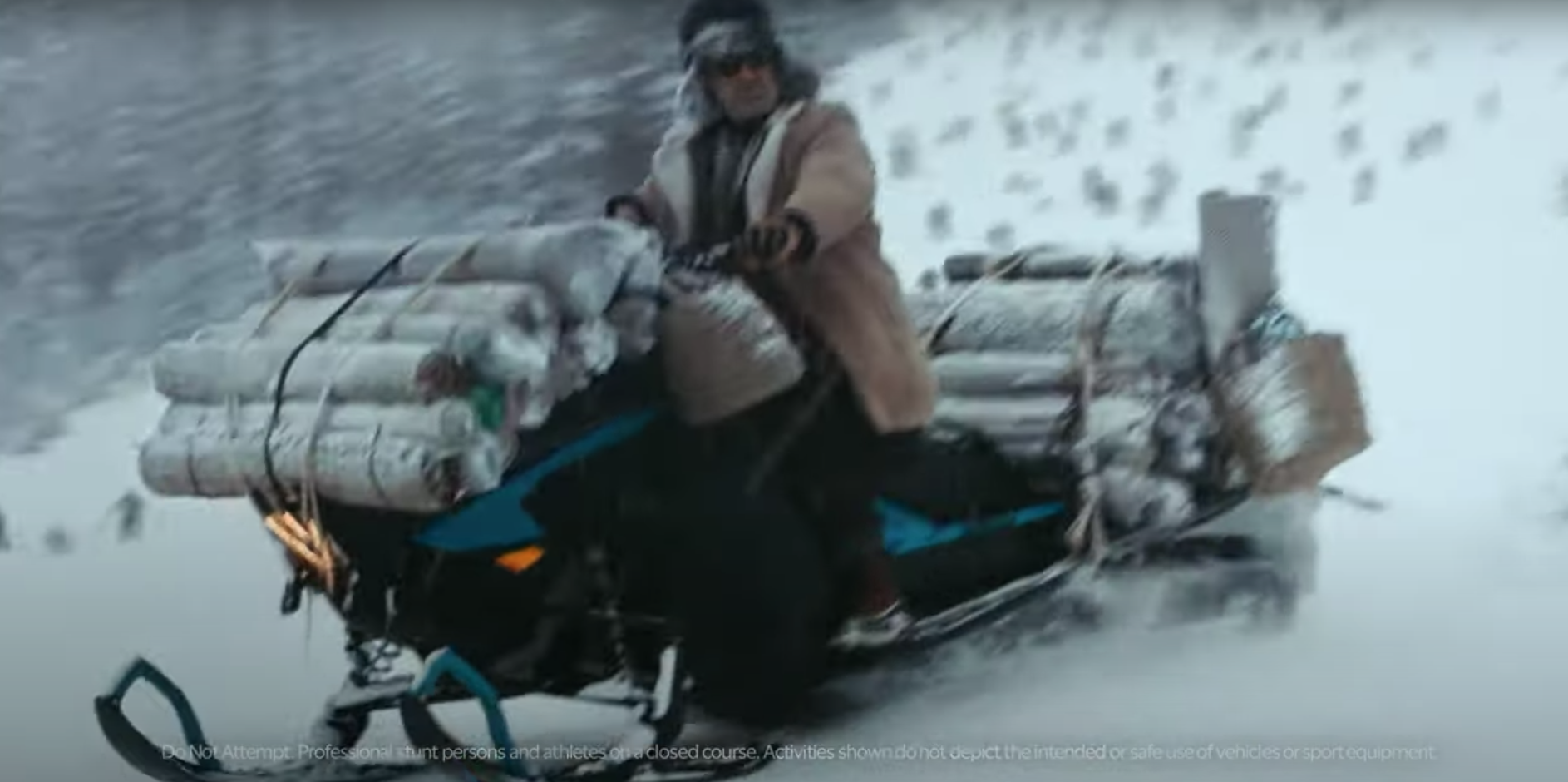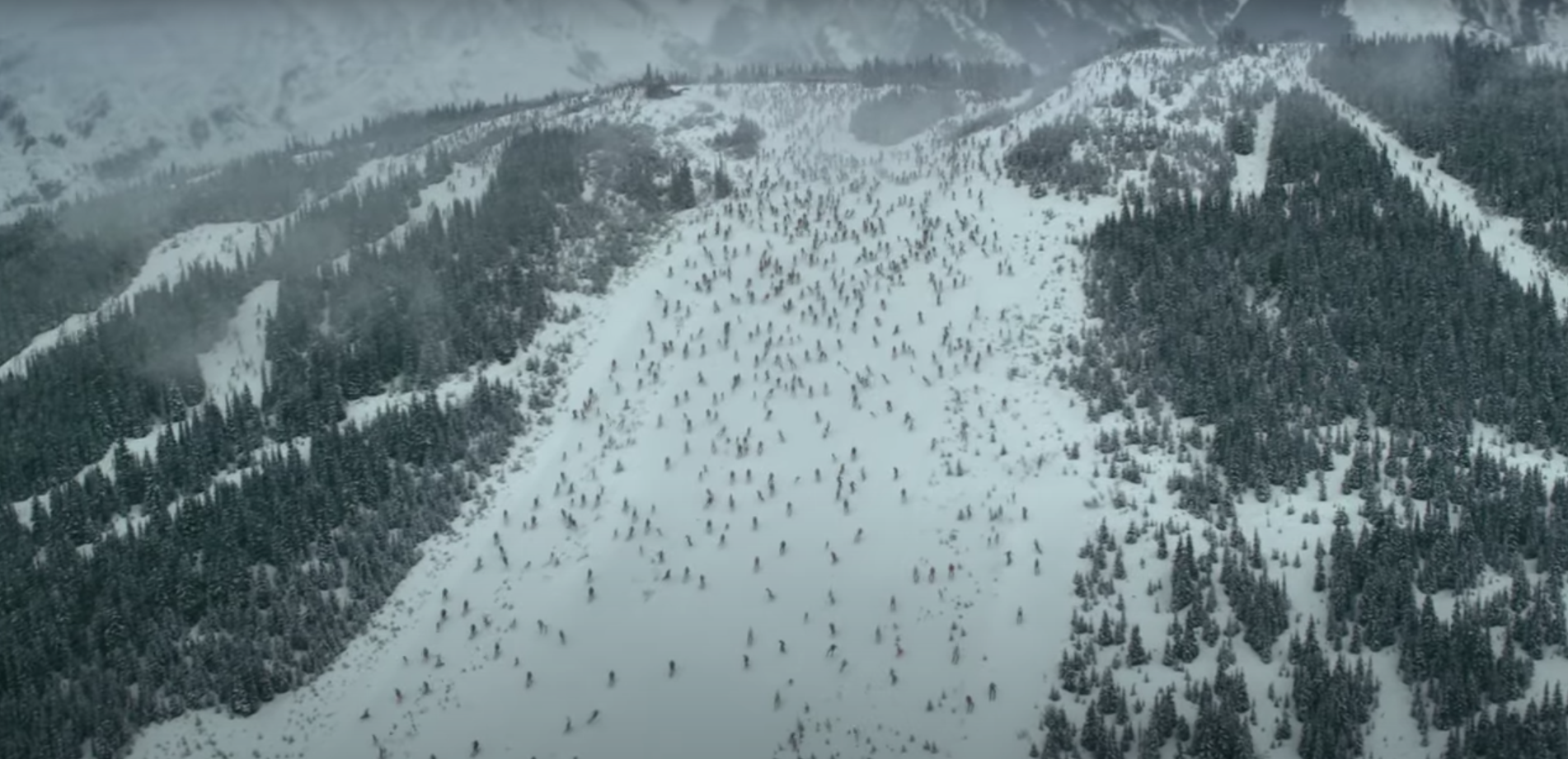Olympic Meddle: Let’s talk about that VISA ad with all the skiers
If you’ve watched more than a few minutes of the 2022 Beijing Winter Olympic Games, you’ve seen the ad.
It’s the one with a couple thousand people thundering down the slopes of an unnamed ski hill in a mysterious wintry location. Some are on skis, some are on snowboards, there’s a dude in a headset for some unknown reason and even a person in a kayak. The music is pleasantly cryptic, and at the end of the ad a banner drops in with the tag: “when more of us play, more of us win.”
Personally, the footage of over-populated ski slopes in the ad drives me bonkers, triggering a combination of heart palpitations and teeth grinding nausea that usually only comes from a Saturday visit to your local fill-in-the-blank North American mega-ski area.
I’m clearly solidly within the target audience for the ad – ie, that dorky dad demographic who’ll watch both Sweden-vs-Canada curling and women’s halfpipe with equal relish. I’ve probably seen the piece 50 times, but the ad is a big whiff for me as a consumer (strike one), a skier (strike two), and a marketer (strike three), as I simply don’t get the message, unless it’s “when we all recreate simultaneously in a confined space, we’re all at equal risk for a season-ending tibia-shattering crash.”
At the same time, as one of a historically small population of people fortunate enough to live in a ski town, I've honestly felt a bit reluctant to openly criticize the piece because of the positive diversity and inclusion message that it’s clearly, if weakly, attempting to achieve. (See also: “Well-meaning but clearly privileged middle aged white guy attempts to write something thoughtful but should clearly stay in his own lane.”).
So, I asked around. The ad has clearly elicited a healthy gut reaction for many and made a lot of people “think.” Not in the way that Visa or their agency probably hoped (“It’ll be thought provoking. Let’s order take out!”), but instead in the mild mockery vein of “what the hell was that?” as well as the vastly more important “is this really the best we can do when we’re talking about two of the most critical topics in the outdoor sector right now – overcrowding and access equity?”
Those “thoughtful” conversations are starting to bubble up on Zoom calls, in emails, and … yes … even on chairlifts above increasingly crowded snowy slopes. See a few of those below.
I’m amazed an agency and a client can so phenomenally miss the mark, especially this year of all years. This crap right here is why I left a long career in advertising. Is there not a planner somewhere who is perhaps somewhat even adjacently connected to the outdoor or ski industry to be at all aware of @epicliftlines and others, the article in the NYT about overcrowding at resorts and so on? What about this looks at all appealing?
The message is perhaps noble on its face (“when more of us play, more of us win”) but this effort may do more harm than good. As it is, skiing is exclusionary in nature. Do you think folks who own houses at resorts want this to be what their home mountain looks like? On the contrary. I'm not sure that I can make the case that one :30 spot from Visa would create significant damage but this just might if this is what "equity" looks like.
But let's just say that the directive in the ad brief was something about encouraging greater participation in skiing? What drove that? Is Visa attempting to be REI? Or is it participation in more people getting credit cards? Or is it more businesses accepting Visa at resorts? Is that really a challenge or problem for Visa? Was this supposed to be a DEI message? Why does Visa care?
— Mark Boles; Hingham, Mass. (Owner, Intrinsic Provisions)
But seriously, when I see a snowboarding dog and a kayaker on the same slope at the same time, it's time to go home. And you can quote me on that.
— Alli Noland, Jackson, Wyoming (president, Terra PR)
We saw that ad and Emily said “and that is why I will no longer ski.” My kids feel the same way. We are spoiled though, as Dad can take off work mid-week and has no qualms about pulling kids from school for a ski day – but hasn’t since they started 10 years ago. So, yeah that commercial sucks.
On the other side, neither Visa nor the ad agency is concerned about reality or what it means to ski a crowded ski area when its flat out dangerous and anxiety producing. I guess they would say something like “Relax, this doesn’t represent reality at all, it’s just a group having a good time.”
For us close to the problem of overcrowding at ski areas, this ad is shocking. For everyone else I imagine they would hear us and shrug and say something like “I only ski Christmas, President’s Day, MLK, and Spring Break at Vail Resorts so it’s ALWAYS like that, big deal.”
The industry has been driving this way for quite awhile now - more participants means more sales. And companies (especially public ones) only want growth. I recommend people look to smaller areas, maybe drive a little further. Work with your employer to be able to ski during the week. Because skiing/riding in that crowd is just a non-starter.
— Keith Reis; Boulder, Colo. (Sanitas Sales Group)
So that Visa ad ... funny, my first thought was, which one is the Visa ad? And as soon as you mentioned all of the skiers, I knew exactly which ad you meant. I remembered the skiers but forgot that the ad is for Visa. So in that sense, it wasn't a successful branding communication to me.
Yes, seeing all of those skiers made me pause a bit in disbelief. I can understand that they are going for more of a metaphorical visual statement, but I see two problems with that: one, if you're not a skier, and this ad is supposed to inspire you, it makes skiing look like a crowded nightmare. How would you know that slopes like that in real life are totally unrealistic? Second, with all of the complaints this year about "Epic Lift Lines"—plus the reality of skier collisions causing injuries and death—the ad seems tone deaf in that sense.
— Cindy Hirschfeld, Basalt, Colo. (Editor, Cross Country Skier … and currently covering the Beijing Olympic Games and posting stories at @xcskiermag). She also recently wrote “For Skiers, A Winter of Discontent” in the New York Times.
I was reading this morning a post from Melanin Base Camp (LINK) about Hawaii’s (particularly native Hawaiians) pleas to not visit. It’s such a setup – a tourism driven economy pleading for people to ‘back off’ for a minute or a year to get their situation stable. Islands are really sensitive environments, socially as much as ecologically. This movement matches all the nationwide ‘loving places to death’ commentary, which I understand but also feels a lot like “now that brown people have decided getting outdoors is a good idea, let’s discourage ‘em” (structural racism).
Ski resorts are hardly sensitive natural environments; they are literally grooming, pruning, enhancing, bulldozing and constructing in forests, after all. So when I ski front country, I’m not expecting a wilderness immersion. But crowds do make me insecure, as I’ve been taken out by whizzing ‘boarders out of control and slightly dread 30 minute-plus waits in line to ride a lift.
That said, the solution I see is not to discourage participation or (gasp) raise prices further to meet demand. For outdoor recreation on public lands, helping people find more close-to-home, undermarketed but amazeballs wild places. This could go for ski hills too, I suppose, although there seem to be fewer options these days, not more, as the march of climate change accelerates.
— Kenji Haroutunian, Laguna Niguel, Calif. (Kenji Consults)
As someone perennially anxious about being sideswiped by an out-of-control teen on the slopes, the well-intentioned ad brought some of my worst "play" fears to life. That aside, it also unwittingly illustrates a reality when it comes to our nation's playscapes: Too much demand and too little supply.
Americans are flocking to the outdoors at unprecedented levels, often with adverse impacts to the plants and animals that many of those areas were originally set aside to protect. Meanwhile, more than 100 million Americans, including 27 million children, don't have access to quality parks close to home - to forest bathe, shoot hoops, or giant slalom. So the question in my mind that the ad provokes is - how do we create the conditions so that more of us can play?
— Shelby Semmes, Waitsfield, Vermont (VP, Trust for Public Lands, New England Region)
I always hesitate to armchair quarterback these things based on my experience in how diluted an agency's idea can become once it emerges from the client review/comment process, even more so with an Olympics sponsorship campaign, likely their biggest sponsorship of the year. That overcrowded downhill scene from the ad was probably a good metaphor for how many people at Visa likely contributed some ideas.
Have to wonder who the target audience is for this, because I can't see how a stampede of skiers is compelling or inspiring to anyone who has ventured outdoors lately and experienced the more-insane-than-usual crowds. It's an all too real nightmare scenario (even more so for anyone with a Vail Resorts Epic Pass...)
From a brand strategy perspective, if the insight about the power of sport and the human condition is "when more of us play, more of us win" it's a "your strategy is showing" execution. It can/should be expressed in a more compelling, less literal manner. Feels like the hectic action/motion/noise from the stampede is over-torqued to make up for the limp copywriting. The power of the sentiment is lost in the literalness and then buried in the avalanche of action.
— Mike Geraci; Jackson, Wyoming (Geraci & Co Brand Strategy)
I agree It’s a jarring ad for anyone who has ever been on a slope with too many people. But I’ve now seen that ad so many times that I find it somehow endearing. The more times I see it, the more I like the message. I wish it wasn’t so muddied by the jarring visuals.
I grew up with two immigrant parents who made plenty of money, but skiing was not a sport that they had ever done. My Mom says she had a chance once in her college years but backed off when a friend of hers broke her leg. My first skiing was through a very cheesy, regional New Jersey ski club. We met in a town park to go to a crappy ski area a few towns over in New Jersey. The density of the slope matched the density of the state of New Jersey – our most populated state. It was really shitty skiing, but it was welcoming!
Many skiers learn to ski because their family skis. My kids will be that way. But lots of people don’t have parents who ski or don’t even have exposure to skiing as an idea. I love the theme of getting everyone out on the slopes. I love how happy all the closeups are in the ad. I love how diverse in race, physical ability or disability, gender, shape of body the ad is. And it also doesn’t look or feel like pandering like so many ads generated by marketing departments who need to show inclusivity.
So much of the advertising around skiing and snowboarding is so Bro-y, even many of the ones highlighting women. It’s refreshing to see an ad that uses a jarring visual to get our attention, and then (for me) turns it into something I have paid more and more attention to each time.
— Ponch Membreno, Peaks Island, Maine (Compass Program Director, Maine Center for Entrepreneurs)
I’m curious about what Visa is actually doing in terms of equity and inclusion in outdoor sports. Like, how much did they spend on the ad versus programs that get people outside (or land management or anything like that)? Is their money actually going where their ad implies it is?
— Heather Hansman, Seattle, Wash. (Author, “Powder Days: Ski Bums, Ski Towns and the Future of Chasing Snow”)
Watching the Winter Games feels like a post-apocalyptic preview of snowsports in the time of climate change, with snow-less slopes, monolithic furnaces that look like nuclear reactors and that absolutely unnerving Visa ad where hundreds of shredders jockey for turning space on what looks like the last white strip of death in the world.
My wife, who still has complications from an on-slope collision 20 years ago, saw the ad for the first-time last night and almost had a bout of PTSD. In shock, her first comment was, "It looks like a fucking anthill."
Then, "I don't like this at all."
Having hardly skied lift-served terrain anywhere in the past two decades, she asked, "Is that what skiing is really like right now?"
— Lurch McSorley, Santa Fe, NM (Volunteer parking coordinator, Meow Wolf)
Skiing should be accessible to everyone -- but that doesn't mean everyone should be on the same slopes at the same time. That ad not only hit a raw nerve among skiers, it was like a root canal without Novocaine. It touched on a pain point that so many ski communities around the nation are facing: there are simply too many skiers in the same places at the same time these days. The visuals didn't say inclusivity, they said overcrowding--not to mention a ridiculously unsafe number of people descending one slope. If VISA had wanted to show inclusivity, show new folks enjoying the sport. Show the reasons why we ski: to get away from crowds, to connect with each other and to experience nature. Just seeing that ad makes me anxious.
— Lisa Lynn, Middlebury, Vermont (Editor, Vermont Ski & Ride)
I've made a similar comparison for those in the flyfishing industry still currently clamoring to "increase participation." And that is: "When all the seats on a plane—or tickets to a stadium for a sporting event or a concert—are sold out, the owners aren't trying to sell more tickets. They are focused on giving those in attendance a more quality experience. Even back in the '90s, Deer Valley Resort used to stop selling day passes when attendance reached a certain number. I know some other resorts are now doing likewise. This was and is not a way to make skiing "more exclusive"—it was a way to ensure safety and a "quality experience."
With just five companies now controlling 77 North American ski resorts—Vail (37) Alterra (15) Powdr (11), Boyne (10), and Aspen (4)—they should be able to predict visitor numbers enough to usher some skiers from their most crowded slopes and mountains to those less crowded. While we all would love to see a more diverse and inclusive community in skiing, what is depicted in that Visa Olympic ad would drive people away from the sport, not toward it.
— Tom Bie, somewhere on a river in Oregon (Editor/publisher, The Drake; and former editor, Powder Magazine)
First, I love how the ad is inclusive. Showing that people from all walks of life, backgrounds, and interests can all participate and enjoy the outdoors is a good thing. You don’t have to look a specific way or be interested in a particular thing to enjoy and experience the things we know and love. Second, it’s not just about skiing. It’s an amalgamation of lots of winter activities and interests. Which is good because the Outdoor industry oftentimes approaches things from an elitist standpoint. And third, it shows snippets of the fun that people have when outside finding their own adventure, which is the point, and really what I think this ad was after.
On the flip side, it hints at the over-tourism problem that a lot of destination locations are dealing with right now, which they are ill equipped to handle. But I think the thing that stresses me out the most about this ad is how it puts the mass market commoditization of outdoor places/public lands front and center. The Epic pass and Ikon passes have done a great job of lowering the cost of a day on the mountain, but they have also exacerbated a lot of traffic problems, pollution problems, etc. I am not sure how we find a balance between inclusion and environmental degradation, but I think this is something we (cities, mountain towns, coastal, etc.) need to figure out.
— Aaron Provine, Salt Lake City, Utah (president, Geartrade.com)
It’s perplexing to me as a skier, but I wonder what impact it has on the 320 million in the US who don’t ski. I don’t think it would make me want to take up the sport. Which is a plus as I see it, as the carbon footprint of the winter sports portrayed is huge. Winter sports are inescapably inaccessible to the vast majority of people on the planet, and “when more of us play more of us win” is an odd message, from an odd messenger. Visa…what even is it? They just make money through the transactional heavy-lifting done by others. They only win if we all buy more.
— Hal Ellms, Middlesex, Vermont (Owner, Pinnacle Outdoor Group).
Is there a more on-point message than "everyone is welcome on the slopes, and we will all have a great time together"? Nope. Has there ever been a long-distance shot that has ever made me want to never ski again more than that panoramic view of a million people on a run? Nope. I can't imagine a way to make skiing seem less safe, fun or enjoyable than showing the entire population of a small city coming down a groomer.
— Wes Allen; Cody, Wyoming (Owner, Sunlight Sports)
I love the message and couldn't agree more with the sentiment of creating a more inclusive, equitable, and accessible outdoors. However, the imagery represents a dystopian reality that, while hyperbolic in this ad, is playing out across the country, as our trails, rivers, slopes, and woods experience an unprecedented crush of use. Unintentionally, Visa put their finger on one of the most critical challenges facing the future of the outdoors - how do we ensure enjoyable access for all people while conserving our vital natural resources in the face of climate change and more and more human pressures? We will only be able to meet that challenge when companies like Visa join the fight and actually work to solve the problem, not just profit from marketing the joy of the outdoors.
—Paul Moinester, Seattle, Wash. (Executive Director, The Outdoor Policy Outfit)
Culley was watching this ad over my shoulder, and he laughed and said “that’s awesome!” I asked him what he thought of the idea that it looked stressful to have that many people on the mountain at once, and he said — “whatever old man. It’s an ad. Get over it.”
— Karrie Thomas, Waitsfield, Vermont (Executive Director, Northern Forest Canoe Trail)



